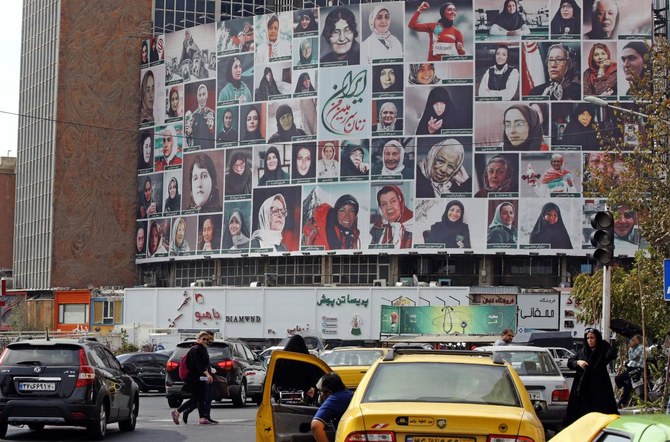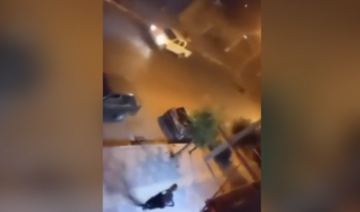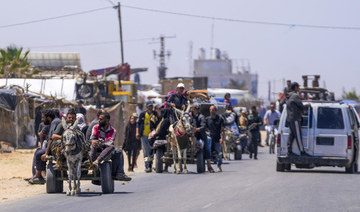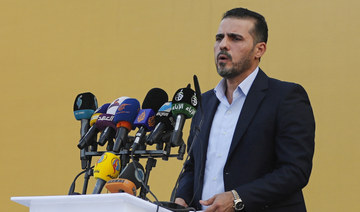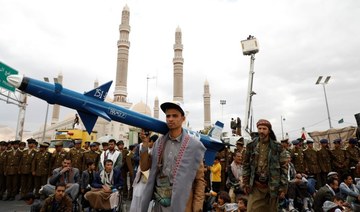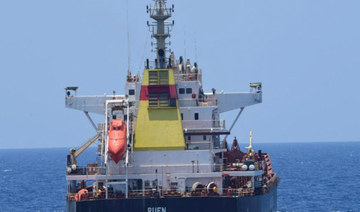RAFAH, Gaza Strip: Israeli strikes on Saturday hit parts of Gaza including Rafah where Israel expanded an evacuation order and the UN warned of “epic” disaster if an outright invasion of the crowded city occurs.
AFP journalists, medics and witnesses reported strikes from the south to the north of the coastal territory, where the UN says aid is blocked after Israeli troops defied international opposition and entered eastern Rafah this week, effectively shutting two crossings.
At least 21 people were killed during strikes in central Gaza and taken to Al-Aqsa Martyrs Hospital in Deir Al-Balah city, a hospital statement said.
Bodies covered in white lay on the ground in a courtyard of the facility. A man in a baseball cap leaned over one body bag, clasping a dust-covered hand that protruded.
The feet of another corpse poked from under a blanket bearing the picture of a large teddy bear.
In Rafah, witnesses reported intense air strikes near the crossing with Egypt, and AFP images showed smoke rising over the city.
Other strikes occurred in north Gaza, they said.
Israeli troops on Tuesday seized and closed the Palestinian side of the Rafah crossing — through which all fuel passes into Gaza — after ordering residents of eastern Rafah to evacuate.
Israel’s military said it went into eastern Rafah to pursue Palestinian militants.
Fighting continued on the Gazan side of the Rafah crossing, the military reported on Friday, before on Saturday expanding its evacuation order to more areas of Rafah’s east.
Evacuation orders
The new order, posted on social media platform X by military spokesman Avichay Adraee, said the designated areas had “witnessed Hamas terrorist activities in recent days and weeks.”
The war began with Hamas’s unprecedented October 7 attack on Israel, which resulted in the deaths of more than 1,170 people, mostly civilians, according to an AFP tally of Israeli official figures.
During their attack, militants also seized hostages. Israel estimates 128 of them remain in Gaza including 36 whom the military says are dead.
Israel’s retaliatory offensive has killed at least 34,971 people in Gaza, mostly women and children, according to the Hamas-run territory’s health ministry.
A US State Department report on Friday said Israel likely violated norms on international law in its use of weapons from the United States but it did not find enough evidence to block shipments.
The State Department submitted its report two days after President Joe Biden publicly threatened to withhold certain bombs and artillery shells if Israel goes ahead with an all-out assault on Rafah, where the United Nations said 1.4 million had been sheltering.
Israeli Prime Minister Benjamin Netanyahu has pledged to “eliminate” Hamas battalions in Rafah and achieve “total victory,” after the army in January said it had dismantled the Hamas command structure in northern Gaza.
But on Saturday Adraee said Hamas “is trying to rebuild” there, and ordered evacuations from the north’s Jabalia and Beit Lahia areas.
After rising criticism from Washington over the civilian impact of Israel’s war against Hamas, the threat to withhold weapons was the first time Biden raised the ultimate US leverage over Israel — its military aid which totals $3 billion annually.
UN Secretary-General Antonio Guterres said Friday that Gaza risked an “epic humanitarian disaster” if Israel launched a full-scale ground operation in Rafah.
While the army said it reopened Kerem Shalom crossing near Rafah on Wednesday, aid agencies cautioned that getting assistance through the militarised area remained extremely difficult.
Aid in limbo
A UN report late Friday cited Martin Griffiths, the UN’s aid chief, as saying closure of the crossings “means no aid.”
Israel has said its Erez crossing into northern Gaza remains open.
The State Department report said it was “reasonable to assess” that Israel has used American weapons in ways inconsistent with standards on humanitarian rights but that the United States could not reach “conclusive findings.”
The report does not affect Biden’s threat to withhold some weapons.
On Friday the White House said it did not yet see a “major ground operation” in Rafah but was watching the situation “with concern.”
Biden’s administration had already paused delivery of 3,500 bombs as Israel appeared ready to attack Rafah.
More than 100,000 people fled the city after the initial evacuation order, the United Nations said on Friday.
Israel on Saturday gave a figure of 300,000, as more Rafah residents piled water tanks, mattresses and other belongings onto vehicles and prepared to flee again.
Malek Al-Zaza, with a trim grey beard, said he has been displaced three times now during the war and found “no food” and “no water” in central Gaza’s Nuseirat camp where he has returned.
“We only have God looking out for us,” he said.
Humanitarian crisis
Israel said it had delivered 200,000 liters of fuel to Gaza on Friday through Kerem Shalom — the amount the United Nations says is needed every day to keep aid trucks moving and hospital generators working.
Reiterating his calls for a ceasefire, Guterres said: “We are actively engaged with all involved for the resumption of the entry of life-saving supplies — including desperately needed fuel — through Rafah and Kerem Shalom crossings.”
The evacuation order on Saturday told residents to go to the “humanitarian zone” of Al-Mawasi, on the coast northwest of Rafah.
That area has “extremely limited access to clean drinking water, latrines, et cetera,” said Sylvain Groulx, Doctors Without Borders (MSF) emergency coordinator in Gaza.
The army late Friday said rocket fire from Gaza wounded an Israeli civilian in the southern city of Beersheba. It was the first time since December that the city had come under Palestinian rocket attack.
In New York, the UN General Assembly voted overwhelmingly to grant the Palestinians additional rights in the global body and backed their drive for full membership.
Palestinian ambassador to the UN Riyad Mansour said the vote was historic, but Israeli Foreign Minister Israel Katz said the move told Hamas that “violence pays off.”





